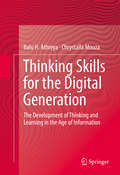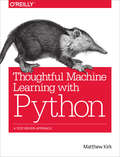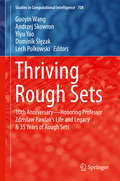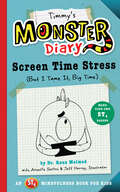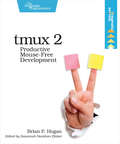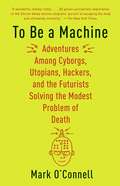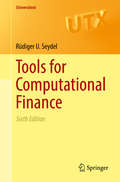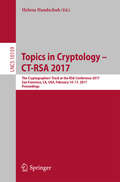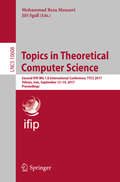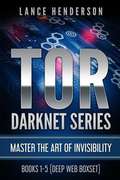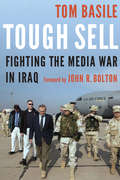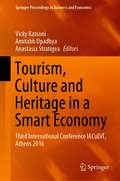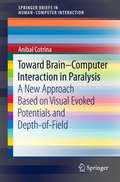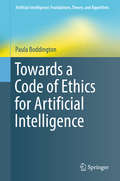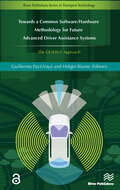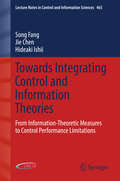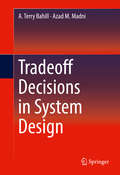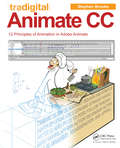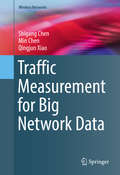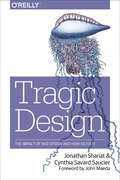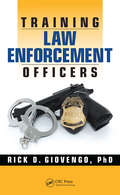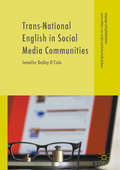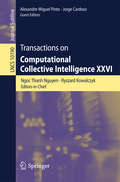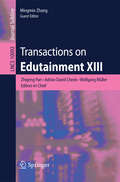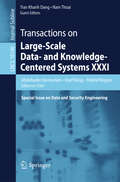- Table View
- List View
Thinking Skills for the Digital Generation
by Balu H. Athreya Chrystalla MouzaThis important text synthesizes the state of knowledge related to thinking and technology and provides strategies for helping young people cultivate thinking skills required to navigate the new digital landscape. The rise of technology has resulted in new ways of searching and communicating information among youth, often creating information "overload". We do not know how the new technologies will affect the ways young people learn and think. There are plenty of warnings about the dangers of information technology, but there is also enormous potential for technology to aid human thinking, which this book explores from an open-minded perspective. Coverage Includes: - An up to date review of the literature on thinking skills in general, and in relation to technology. - Practical guidelines for thinking with technology. - A scholarly review of the characteristics of the digital generation. - A discussion of the various steps involved in the thinking process. - A historical context of the Information Age and the transition from oral history, to printing press, to the Internet. Thinking Skills for the Digital Generation: The Development of Thinking and Learning in the Age of Information is an invaluable reference for educators and research professionals particularly interested in educational technology, and improving thinking and problem-solving skills.
Thoughtful Machine Learning with Python: A Test-Driven Approach
by Matthew KirkGain the confidence you need to apply machine learning in your daily work. With this practical guide, author Matthew Kirk shows you how to integrate and test machine learning algorithms in your code, without the academic subtext.Featuring graphs and highlighted code examples throughout, the book features tests with Python’s Numpy, Pandas, Scikit-Learn, and SciPy data science libraries. If you’re a software engineer or business analyst interested in data science, this book will help you:Reference real-world examples to test each algorithm through engaging, hands-on exercisesApply test-driven development (TDD) to write and run tests before you start codingExplore techniques for improving your machine-learning models with data extraction and feature developmentWatch out for the risks of machine learning, such as underfitting or overfitting dataWork with K-Nearest Neighbors, neural networks, clustering, and other algorithms
Thriving Rough Sets
by Guoyin Wang Andrzej Skowron Yiyu Yao Dominik Ślęzak Lech PolkowskiThis special book is dedicated to the memory of Professor Zdzisław Pawlak, the father of rough set theory, in order to commemorate both the 10th anniversary of his passing and 35 years of rough set theory. The book consists of 20 chapters distributed into four sections, which focus in turn on a historical review of Professor Zdzisław Pawlak and rough set theory; a review of the theory of rough sets; the state of the art of rough set theory; and major developments in rough set based data mining approaches. Apart from Professor Pawlak's contributions to rough set theory, other areas he was interested in are also included. Moreover, recent theoretical studies and advances in applications are also presented. The book will offer a useful guide for researchers in Knowledge Engineering and Data Mining by suggesting new approaches to solving the problems they encounter.
Timmy's Monster Diary: Screen Time Stress (But I Tame It, Big Time) (Monster Diaries #2)
by Raun Melmed Annette SextonMeet Timmy, a lovable monster who can’t get enough of the coolest gadgets and video games. Too bad he doesn’t realize how much time he spends each day in front of a screen. In the same humorous spirit of Diary of a Wimpy Kid comes Timmy’s Monster Diary: Screen Time Stress. Using the “Time-Telling” and “ST4” techniques developed by Dr. Raun Melmed of the Melmed Center in Arizona, Timmy’s Monster Diary teaches kids how to self-monitor the amount of time they spend on technology. Timmy’s hilarious doodles and diary entries chronicle his delightful adventures, misadventures, and eventual triumph in a funny, relatable way. It’s the one book that kids will want to turn off the TV and read! Timmy’s Monster Diary also includes a resource section to help parents and teachers implement Dr. Melmed’s methods, plus ST4 reminders that kids can remove, color, and place around the house. Ages 6–12 Don’t miss Marvin’s ADHD adventures in Book 1.
tmux 2: Productive Mouse-Free Development
by Brian P. HoganYour mouse is slowing you down. The time you spend context switching between your editor and your consoles eats away at your productivity. Take control of your environment with tmux, a terminal multiplexer that you can tailor to your workflow. With this updated second edition for tmux 2.3, you'll customize, script, and leverage tmux's unique abilities to craft a productive terminal environment that lets you keep your fingers on your keyboard's home row. You have a database console, web server, test runner, and text editor running at the same time, but switching between them and trying to find what you need takes up valuable time and breaks your concentration. By using tmux 2.3, you can improve your productivity and regain your focus. This book will show you how. This second edition includes many features requested by readers, including how to integrate plugins into your workflow, how to integrate tmux with Vim for seamless navigation - oh, and how to use tmux on Windows 10. Use tmux to manage multiple terminal sessions in a single window using only your keyboard. Manage and run programs side by side in panes, and create the perfect development environment with custom scripts so that when you're ready to work, your programs are waiting for you. Manipulate text with tmux's copy and paste buffers, so you can move text around freely between applications. Discover how easy it is to use tmux to collaborate remotely with others, and explore more advanced usage as you manage multiple tmux sessions, add custom scripts into the tmux status line, and integrate tmux with your system. Whether you're an application developer or a system administrator, you'll find many useful tricks and techniques to help you take control of your terminal.
To Be a Machine: Adventures Among Cyborgs, Utopians, Hackers, and the Futurists Solving the Modest Problem of Death
by Mark O'ConnellAn eye-opening journey into a world of visionaries, billionaires, and eccentrics harnessing technology for nothing less than the salvation of mankindTranshumanism is a movement pushing the limits of our bodies—our capabilities, intelligence, and lifespans—in the hopes that, through technology, we can become something better than ourselves. It has found support among Silicon Valley billionaires and some of the world’s biggest businesses. In To Be a Machine, journalist Mark O'Connell explores the staggering possibilities and moral quandaries that present themselves when you of think of your body as a device. He visits the world's foremost cryonics facility to witness how some have chosen to forestall death. He discovers an underground collective of biohackers, implanting electronics under their skin to enhance their senses. He meets a team of scientists urgently investigating how to protect mankind from artificial superintelligence.Where is our obsession with technology leading us? What does the rise of AI mean not just for our offices and homes, but for our humanity? Could the technologies we create to help us eventually bring us to harm? Addressing these questions, O'Connell presents a profound, provocative, often laugh-out-loud-funny look at an influential movement. In investigating what it means to be a machine, he offers a surprising meditation on what it means to be human.
Tools for Computational Finance
by Rüdiger U. SeydelComputational and numerical methods are used in a number of ways across the field of finance. It is the aim of this book to explain how such methods work in financial engineering. By concentrating on the field of option pricing, a core task of financial engineering and risk analysis, this book explores a wide range of computational tools in a coherent and focused manner and will be of use to anyone working in computational finance. Starting with an introductory chapter that presents the financial and stochastic background, the book goes on to detail computational methods using both stochastic and deterministic approaches.Now in its sixth edition, Tools for Computational Finance has been significantly revised and contains: Several new parts such as a section on extended applications of tree methods, including multidimensional trees, trinomial trees, and the handling of dividends;Additional material in the field of generating normal variates with acceptance-rejection methods, and on Monte Carlo methods;115 exercises, and more than 100 figures, many in color.Written from the perspective of an applied mathematician, all methods are introduced for immediate and straightforward application. A ‘learning by calculating’ approach is adopted throughout this book, enabling readers to explore several areas of the financial world.Interdisciplinary in nature, this book will appeal to advanced undergraduate and graduate students in mathematics, engineering, and other scientific disciplines as well as professionals in financial engineering.
Topics in Cryptology – CT-RSA 2017
by Helena HandschuhThis book constitutes the refereed proceedings of the Cryptographer's Track at the RSA Conference 2017, CT-RSA 2017, held in San Francisco, CA, USA, in February 2017. The 25 papers presented in this volume were carefully reviewed and selected from 77 submissions. CT-RSA has become a major publication venue in cryptography. It covers a wide variety of topics from public-key to symmetric key cryptography and from cryptographic protocols to primitives and their implementation security. This year selected topics such as cryptocurrencies and white-box cryptography were added to the call for papers.
Topics in Theoretical Computer Science
by Mohammad Reza Mousavi Jiří SgallThis book constitutes the refereed proceedings of the Second IFIP WG 1. 8 International Conference on Topics in Theoretical Computer Science, TTCS 2017, held in Tehran, Iran, in September 2017. The 8 papers presented in this volume were carefully reviewed and selected from 20 submissions. They were organized in topical sections named: algorithms and complexity; and logic, semantics, and programming theory.
Tor Darknet: Master the Art of Invisibility
by Lance HendersonWant to surf the web anonymously? Cloak yourself in shadow? I will show you how to become a ghost in the machine - leaving no tracks back to your ISP. This book covers it all! Encrypting your files, securing your PC, masking your online footsteps with Tor browser, VPNs, Freenet and Bitcoins, and all while giving you peace of mind with TOTAL 100% ANONYMITY. - How to Be Anonymous Online AND Offline - Step by Step Guides for Tor, Freenet, I2P, VPNs, Usenet and more - Browser Fingerprinting - Anti-Hacking and Counter-forensics Techniques - Photo & Video Metadata - How to Encrypt Files (I make this super simple) - How to Defeat NSA Spying - How to Browse the Deep Web - How to Protect Your Identity - How to Hide Anything! Tor & The Dark Art of Anonymity The NSA hates Tor. So does the FBI. Even Google wants it gone, as do Facebook and Yahoo and every other soul-draining, identity-tracking vampiric media cartel that scans your emails and spies on your private browsing sessions to better target you - but there's hope. This manual will give you the incognito tools that will make you a master of anonymity! Covered in Tor: - Browse the Internet Anonymously - Darkcoins, Darknet Marketplaces & Opsec Requirements - Tor Hidden Servers - How to Not Get Caught - Counter-Forensics the FBI Doesn't Want You to Know About! - Windows vs. Linux Network Security - Cryptocurrency (Real Bitcoin Anonymity) - Supercookies & Encryption - Preventing Marketers and Debt Collectors From Finding You - How to Protect Your Assets - Home, Money & Family! - How to Hide Anything from even the most trained IRS agents The Invisibility Toolkit Within this book lies top secrets known only to the FBI and a few law enforcement agencies: How to disappear in style and retain assets. How to switch up multiple identities on the fly and be invisible such that no one; not your ex, not your parole officer, nor even the federal government can find you. Ever. You'll learn: - How to disappear overseas - How to wear a perfect disguise. - How to bring down a drone. - How to be invisible in Canada, Thailand, China or the Philippines. - How to use Darkcoins on the run. - How to fool skip tracers, child support courts, student loan collectors - How to sneak into Canada - How to be anonymous online using Tor, Tails and the Internet Underground - Edward Snowden's biggest mistake. Usenet: The Ultimate Guide The first rule of Usenet: Don't Talk About Usenet! But times have changed and you want what you want. Usenet is the way to go. I will show you: - How to use Usenet - which groups to join, which to avoid - How to be anonymous online - Why Usenet is better than torrents - How to use Tor, How to use PGP, Remailers/Mixmaster, SSL. - How to encrypt your files - Which Vpn and Usenet companies rat you out, and which won't. - How to Stay Anonymous Online You've probably read The Hacker Playbook by Peter Kim and the Art of Invisibility by Kevin Mitnick. While those are fine books, you need this super pack to take it to the NEXT LEVEL. Scroll to the top of the page and select the "buy" button and wear a cloak of invisibility INSTANTLY!
Tough Sell: Fighting the Media War in Iraq
by Tom Basile John R. BoltonLike the War on Terror, the Media War rages on. More than ever, America’s ability to fight and win against ISIS requires that we understand how best to communicate about war in the digital age. Tom Basile takes readers behind the scenes during his time as a civilian advisor in Iraq during the Iraq War, describing his mission and the struggle to communicate about the war as it became more deadly and less popular at home. The U.S.-led coalition wasn’t merely engaged in a fight to build a more tolerant, participatory society against incredible odds. It was also in a constant clash with forces that influenced public perception about the mission. During those difficult years, it became clear that warfare was now, more than ever, a blend of policy, politics, and the business of journalism. Basile critiques the media’s reporting and assesses the Bush administration’s home-front communications strategy to argue that if policymakers fail to effectively articulate their strategy, manage their message, and counter misinformation, they will find themselves unable to execute that policy. That, Basile argues, places the United States at great risk. Tough Sell blends Basile’s personal story with lessons from the media war in Iraq that can improve our ability to communicate about and prosecute the War on Terror.
Tourism, Culture and Heritage in a Smart Economy: Third International Conference IACuDiT, Athens 2016 (Springer Proceedings in Business and Economics)
by Vicky Katsoni Amitabh Upadhya Anastasia StratigeaThis book explores the ways in which information and communication technologies (ICTs) offer a powerful tool for the development of smart tourism. Numerous examples are presented from across the entire spectrum of cultural and heritage tourism, including art, innovations in museum interpretation and collections management, cross-cultural visions, gastronomy, film tourism, dark tourism, sports tourism, and wine tourism. Emphasis is placed on the importance of the smart destinations concept and a knowledge economy driven by innovation, creativity, and entrepreneurship. New modes of tourism management are described, and tourism products, services, and strategies for the stimulation of economic innovation and promotion of knowledge transfer are outlined. The potential of diverse emerging ICTs in this context is clearly explained, covering location-based services, internet of things, smart cities, mobile services, gamification, digital collections and the virtual visitor, social media, social networking, and augmented reality. The book is edited in collaboration with the International Association of Cultural and Digital Tourism (IACuDiT) and includes the proceedings of the Third International Conference on Cultural and Digital Tourism.
Toward Brain-Computer Interaction in Paralysis
by Anibal CotrinaThis book presents up-to-date information on Brain-computer Interfaces (BCI). BCIs are systems that record brain signals, extract features and translate them into computer commands. For instance, in BCIs based on the steady-state visual evoked potentials (SSVEP-BCI), brain potentials evoked by visual stimuli are used for controlling computer-based devices. Inspired by the optical phenomenon of depth of field, this book introduces, describes, and evaluates a novel way of setting visual stimuli for SSVEP-BCI. It employs two stimuli that were placed at different distances from the subjects so that if one stimulus is focused on, the other one is non-focused. This assessment allows SSVEP-BCI users to modulate their brain signals by shifting their focus because focused and non-focused stimuli evoke different brain potentials. It allows people to send two brain commands with high accuracy rate by shifting their focus. Hence, computer interaction systems can be proposed for people with paralysis, such as patients with amyotrophic lateral sclerosis since focusing mechanism does not demand head, neck, or eyeball movements. The matter assessed in this book that includes offline and online experiments, is useful for researchers in human-machine interaction who are looking for relevant possibilities of improving the quality of life of people in paralysis situation.
Towards a Code of Ethics for Artificial Intelligence
by Paula BoddingtonThe author investigates how to produce realistic and workable ethical codes or regulations in this rapidly developing field to address the immediate and realistic longer-term issues facing us. She spells out the key ethical debates concisely, exposing all sides of the arguments, and addresses how codes of ethics or other regulations might feasibly be developed, looking for pitfalls and opportunities, drawing on lessons learned in other fields, and explaining key points of professional ethics. The book provides a useful resource for those aiming to address the ethical challenges of AI research in meaningful and practical ways.
Towards a Common Software/Hardware Methodology for Future Advanced Driver Assistance Systems: The Deserve Approach (River Publishers Series In Transport Technology Is A Series Of Comprehensive Academic And Professional Books Which Focus On Theory And Applications In The Various Disciplines Within Transport Technology, Namely Automotive And Aerospace. The Series Will Serve As A Multi-disciplinary Resource Linking Transport Technology With Society. The Book Series Fulfills The Rapidly Growing Worldwide Interest I)
by Guillermo Payá-Vayá Holger BlumeThe European research project DESERVE (DEvelopment platform for Safe and Efficient dRiVE, 2012-2015) had the aim of designing and developing a platform tool to cope with the continuously increasing complexity and the simultaneous need to reduce cost for future embedded Advanced Driver Assistance Systems (ADAS). For this purpose, the DESERVE platform profits from cross-domain software reuse, standardization of automotive software component interfaces, and easy but safety-compliant integration of heterogeneous modules. This enables the development of a new generation of ADAS applications, which challengingly combine different functions, sensors, actuators, hardware platforms, and Human Machine Interfaces (HMI). This book presents the different results of the DESERVE project concerning the ADAS development platform, test case functions, and validation and evaluation of different approaches. The reader is invited to substantiate the content of this book with the deliverables published during the DESERVE project. Technical topics discussed in this book include:Modern ADAS development platforms;Design space exploration;Driving modelling;Video-based and Radar-based ADAS functions;HMI for ADAS;Vehicle-hardware-in-the-loop validation systems
Towards Integrating Control and Information Theories
by Song Fang Jie Chen Hideaki IshiiThis book investigates the performance limitation issues in networked feedback systems. The fact that networked feedback systems consist of control and communication devices and systems calls for the integration of control theory and information theory. The primary contributions of this book lie in two aspects: the newly-proposed information-theoretic measures and the newly-discovered control performance limitations. We first propose a number of information notions to facilitate the analysis. Using those notions, classes of performance limitations of networked feedback systems, as well as state estimation systems, are then investigated. In general, the book presents a unique, cohesive treatment of performance limitation issues of networked feedback systems via an information-theoretic approach. This book is believed to be the first to treat the aforementioned subjects systematically and in a unified manner, offering a unique perspective differing from existing books.
Tradeoff Decisions in System Design
by A. Terry Bahill Azad M. MadniThis textbook is about three key aspects of system design: decision making under uncertainty, trade-off studies and formal risk analyses. Recognizing that the mathematical treatment of these topics is similar, the authors generalize existing mathematical techniques to cover all three areas. Common to these topics are importance weights, combining functions, scoring functions, quantitative metrics, prioritization and sensitivity analyses. Furthermore, human decision-making activities and problems use these same tools. Therefore, these problems are also treated uniformly and modeled using prospect theory. Aimed at both engineering and business practitioners and students interested in systems engineering, risk analysis, operational management, and business process modeling, Tradeoff Decisions in System Design explains how humans can overcome cognitive biases and avoid mental errors when conducting trade-off studies and risk analyses in a wide range of domains. With generous use of examples as a common thread across chapters this book.
Tradigital Animate CC: 12 Principles of Animation in Adobe Animate
by Stephen BrooksLearn how to bridge the gap between the traditional animation principles and digital software. Tradigital Flash: 12 Principles of Animation in Adobe Flash brings the essentials of traditional animation and Adobe Flash together. The early masters of animationcreated a list of 12 principles which are important for anyone who wants to create interesting and believable animation. Digital animation continues to make incredible technological advancements that give animators the capability to produce visually stunning work. New technology, however, also has a tendency to create an environment where animators are so focused on adapting to the new workflow that they tend to dismiss these fundamental animation principles… which often leads to poor and lifeless character animation. Tradigital Flash helps you focus on these principles while using the program’s wide array of features to create believable animation, consistently. Tradigital Flash joins three other Tradigital books covering Maya, Blender, and 3ds Max. This new volume in the series approaches the topic in a different way, giving readers both a practical look at the software, and providing a theoretical understanding of the genre. Learn a new principle in each chapter, the Flash tools most related to it and how to put it all together. A plethora of examples demonstrate the good methods which animators should use in Flash, how to avoid the bad ones and ways to create a workflow that works for you. An easy-to-follow approach with examples throughout the book that build on each other, showing how the principles act together. A companion website www.rubberonion.com/tradigital-animate features more examples, downloadable FLA resource files, video tutorials. Key Features Every chapter teaches you a principle, shows you the corresponding tool or tools, and shows you how to all put it together. A wide array of examples demonstrate the good, bad, and sometimes ugly procedures an animator can practice with Flash. A follow-along approach, where examples throughout the book build on each other, showing how the principles act together. A companion website features more examples, downloadable swf resource files, video tutorials.
Traffic Measurement for Big Network Data
by Shigang Chen Min Chen Qingjun XiaoThis book presents several compact and fast methods for online traffic measurement of big network data. It describes challenges of online traffic measurement, discusses the state of the field, and provides an overview of the potential solutions to major problems. The authors introduce the problem of per-flow size measurement for big network data and present a fast and scalable counter architecture, called Counter Tree, which leverages a two-dimensional counter sharing scheme to achieve far better memory efficiency and significantly extend estimation range. Unlike traditional approaches to cardinality estimation problems that allocate a separated data structure (called estimator) for each flow, this book takes a different design path by viewing all the flows together as a whole: each flow is allocated with a virtual estimator, and these virtual estimators share a common memory space. A framework of virtual estimators is designed to apply the idea of sharing to an array of cardinality estimation solutions, achieving far better memory efficiency than the best existing work. To conclude, the authors discuss persistent spread estimation in high-speed networks. They offer a compact data structure called multi-virtual bitmap, which can estimate the cardinality of the intersection of an arbitrary number of sets. Using multi-virtual bitmaps, an implementation that can deliver high estimation accuracy under a very tight memory space is presented. The results of these experiments will surprise both professionals in the field and advanced-level students interested in the topic. By providing both an overview and the results of specific experiments, this book is useful for those new to online traffic measurement and experts on the topic.
Tragic Design: The Impact of Bad Product Design and How to Fix It
by Cynthia Savard Saucier Jonathan ShariatBad design is everywhere, and its cost is much higher than we think. In this thought-provoking book, authors Jonathan Shariat and Cynthia Savard Saucier explain how poorly designed products can anger, sadden, exclude, and even kill people who use them. The designers responsible certainly didn’t intend harm, so what can you do to avoid making similar mistakes?Tragic Design examines real case studies that show how certain design choices adversely affected users, and includes in-depth interviews with authorities in the design industry. Pick up this book and learn how you can be an agent of change in the design community and at your company.You’ll explore:Designs that can kill, including the bad interface that doomed a young cancer patientDesigns that anger, through impolite technology and dark patternsHow design can inadvertently cause emotional painDesigns that exclude people through lack of accessibility, diversity, and justiceHow to advocate for ethical design when it isn’t easy to do soTools and techniques that can help you avoid harmful design decisionsInspiring professionals who use design to improve our world
Training Law Enforcement Officers
by Rick D. GiovengoThis how-to guide covers every aspect of law enforcement training, from training academy administration, to designing curricula, to identifying and utilizing qualified instructors. Using the latest methodologies, technologies, and best practices, Training Law Enforcement Officers gives law enforcement administrators, training specialists, instructors, instructional systems designers, and academy directors a proven way to conduct training for all levels of practitioners, from basic law enforcement to high-risk law enforcement. At a time when scrutiny of law enforcement officers is on the rise, Training Law Enforcement Officers is an essential guide for those criminal justice practitioners seeking to minimize police error and make today’s police force the best that it can be.
Trans-National English in Social Media Communities
by Jennifer Dailey-O’CainThis book explores the use of English within otherwise local-language conversations by two continental European social media communities. The analysis of these communities serves not only as a comparison of online language practices, but also as a close look at how globalization phenomena and ‘international English’ play out in the practices of everyday life in different non-English-speaking countries. The author concludes that the root of the distinctive practices in the two communities studied is the disparity between their language ideologies. She argues that community participants draw on their respective national language ideologies, which have developed over centuries, but also reach beyond any static forms of those ideologies to negotiate, contest, and re-evaluate them. This book will be of interest to linguists and other social scientists interested in social media, youth language and the real-world linguistic consequences of globalization.
Transactions on Computational Collective Intelligence XXVI
by Ngoc Thanh Nguyen Ryszard Kowalczyk Alexandre Miguel Pinto Jorge CardosoThese transactions publish research in computer-based methods of computational collective intelligence (CCI) and their applications in a wide range of fields such as the semantic Web, social networks, and multi-agent systems. TCCI strives to cover new methodological, theoretical and practical aspects of CCI understood as the form of intelligence that emerges from the collaboration and competition of many individuals (artificial and/or natural). The application of multiple computational intelligence technologies, such as fuzzy systems, evolutionary computation, neural systems, consensus theory, etc. , aims to support human and other collective intelligence and to create new forms of CCI in natural and/or artificial systems. This twenty-sixth issue is a special issue with selected papers from the First International KEYSTONE Conference 2015 (IKC 2015), part of the keystone COST Action IC1302.
Transactions on Edutainment XIII
by Mingmin Zhang Wolfgang Müller Adrian David Cheok Zhigeng PanThis journal subline serves as a forum for stimulating and disseminating innovative research ideas, theories, emerging technologies, empirical investigations, state-of-the-art methods, and tools in all different genres of edutainment, such as game-based learning and serious games, interactive storytelling, virtual learning environments, VR-based education, and related fields. It covers aspects from educational and game theories, human-computer interaction, computer graphics, artificial intelligence, and systems design. The 25 papers presented in the 13th issue were organized in topical sections named: learning games and visualization; virtual reality and applications; 3D graphics technology, multimedia computing, and others.
Transactions on Large-Scale Data- and Knowledge-Centered Systems XXXI
by Abdelkader Hameurlain Josef Küng Roland Wagner Tran Khanh Dang Nam ThoaiThe LNCS journal Transactions on Large-Scale Data- and Knowledge-Centered Systems focuses on data management, knowledge discovery, and knowledge processing, which are core and hot topics in computer science. Since the 1990s, the Internet has become the main driving force behind application development in all domains. An increase in the demand for resource sharing across different sites connected through networks has led to an evolution of data- and knowledge-management systems from centralized systems to decentralized systems enabling large-scale distributed applications providing high scalability. Current decentralized systems still focus on data and knowledge as their main resource. Feasibility of these systems relies basically on P2P (peer-to-peer) techniques and the support of agent systems with scaling and decentralized control. Synergy between grids, P2P systems, and agent technologies is the key to data- and knowledge-centered systems in large-scale environments. This, the 31st issue of Transactions on Large-Scale Data- and Knowledge-Centered Systems, contains six revised selected papers from the 2nd International Conference on Future Data and Security Engineering, FDSE 2015, and the 9th International Conference on Advanced Computing and Applications, ACOMP 2015, which were held in Ho Chi Minh City, Vietnam, in November 2015. Topics covered include big data analytics, data models and languages, security and privacy, complex business services, and cloud data management.
